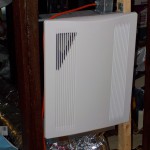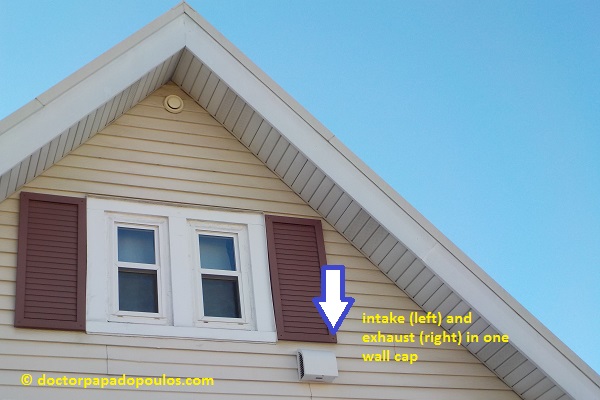Panasonic ERV Review: How I Installed the FV‑04VE1
Dear DIY friends, in this post I’ll describe how I stalled in my “Old House”, the ‘notorious’ 1928 villa of Baltimore, the Panasonic ERV FV-04VE1, an energy recovery ventilator with 40CFM  throughput and around 66% efficiency, according to its specifications.
throughput and around 66% efficiency, according to its specifications.
This is not a paid review nor is it the finest work I’ve ever done 😉 Rather, a sample install with some numbers for you to get a feel for what this “thing” can do and what it cannot.
Who Needs an Energy Recovery Ventilator? Why Don’t You Simply Open a Window?
So why on earth would anyone spend about $500 and make a 5.5″ hole in the wall, run ducts, and set up a box in the middle of the house, just for fresh air, when you could, like everyone else, open a freakin’ window?
Here where I live in Baltimore, MD, the cost of cooling in the summer usually surpasses the cost of heating. In terms of energy cost, if you convert therms into kWh and take efficiencies into account, natural gas here is about 4x cheaper than electricity. In addition, my natural gas water heater that I also use for radiant heat for my radiator loop is 96% efficient, ie. it only wastes 4% of the energy and 96% of the heat goes into the water; however, air conditioners are usually nowhere near as efficient when in cooling mode. Since electricity costs also 4x as much as gas, we want to focus on the summer season expenses.
Baltimore, in the Washington D.C. metro area, is in a mixed climate: cold winters and hot-humid summers. This makes “building science” quite complicated. For example the ‘simple’ question where to install a vapor retarder is up for debate, when in other climates the answer is obvious. Ventilating your house via the traditional method called ‘open window’ is acceptable in early spring and late fall, when the outdoor air is around room temperature and the relative humidity is pleasant in the 35-45% range. Opening windows in the summer feels like opening a sauna door, while in the winter the air is so cold it causes condensation. Furthermore, dry winter air is very uncomfortable; hence, an ERV is a smart choice for energy and comfort, but there is more to it.
Panasonic ERV Installation
I installed the Panasonic ERV FV‑04VE1 on the upper floor and also purchased the innovative wall cap, see below. The great thing about this wall cap is you only need to drill one hole, 5.5 inches diameter. The cap handles intake and exhaust as shown below and looks good:

Indoors I used insulated flex duct all the way to the ERV. When you have many turns or a rather long run, use a larger diameter to reduce friction. I believe this ERV has 4″ duct connections. I used 6″ because I had some leftovers.
What You Need to Know About this ERV
I’ve been using this ERV for about three years now and have learned a few things about the nature of ERVs; not everything is as great as one would expect. Overall, however, I recommend this ERV and think it’s a great choice at that particular price point.
A good characteristic of this ERV is it offers a slow mode of 20 CFM, which I have never used and want to look into. When air moves slower through the ERV’s core, the heat has more time to move across. I assume the efficiency should be higher in the slower mode.
For a total area of about 1,000 sq ft, about 90 sq meters, 40 CFM works well. When the outdoor temperature drops below 5C (45F) you would definitely want to use a timer as the air will be very dry and rather cold. This particular unit switches into exhaust-only mode when the temperature drops below freezing. The larger FanTech ERV I installed for the lower floors does not do that. I guess internally the unit would freeze up if exposed to very low temperatures.
Location: Where to install
Location is a big issue in a retrofit scenario. The air is being pumped in a certain direction so it will be ‘hitting’ certain spots. If you install the unit in a wall like I did, the air will move horizontally so you wouldn’t want to sit near it. Perhaps a ceiling install is a better choice when possible as the warmer air up there will mix quickly with the cooler air from outside and the draft won’t be as noticeable.
Noise is another consideration. This ERV is very quiet. The whole house Fantech ERV I have is very loud and that’s why I had to install it in the basement. This ERV is so quiet you can really use it in a bedroom. Perhaps at 20 CFM it will be almost unnoticeable, but I haven’t tried at low speed yet.
Another thing to think about before installing is how your ‘expensive’ air conditioned air will circulate. Ideally you wouldn’t want the ERV to suck the air directly from your air conditioner and exhaust it to the outside. I found it better to have the ERV blow the air into the same direction as the air conditioner and exhaust stale air instead.
Performance
Is 40 CFM really enough for a 1,000 sq ft area? Yes it is! But only in spring and fall. In the winter it’s actually too much! If this ERV had an efficiency of 90% you could probably use it below freezing with good results; however, the dry outdoor air is a real problem. Even if the heat it recovers is very good, the dry air will make the room very uncomfortable. This appears to be a big issue with both ERVs I have. In the winter I have to use a remote control or a timer to keep ventilation times at a minimum.
Since this is a wood frame house and this ERV is installed on the upper floor, the summer time is a little difficult. The high temperatures and high moisture levels we have in the summer require additional ventilation. 40 CFM isn’t really enough for the summer time. As temperatures go up, also odors may become noticeable from various building materials. We have some of the woodwork exposed in our cathedral ceiling and we get a bit of a ‘museum’ kind of odor coming from the aged wood. The ERV is good at removing these odors; however, for 1,000 sq ft we would probably need around 100 CFM to make it perfect in the summer time.
100 CFM would create new issues, however. First, the noise would be more noticeable. Second, since ERVs aren’t 100% efficient, more air means more energy is wasted. A feasible solution may be to use two of these Panasonic ERVs and only use both at certain times and seasons throughout the year.
Having several units is probably not a bad idea: the air floor will be better and there should be less noise. Having two units across from each other should produce a nice rotation of fresh air without being bothersome.
Other Projects
You may also want to check out my post on ERV pros and cons, the Buderus radiator review, and how to backup virtual machines.